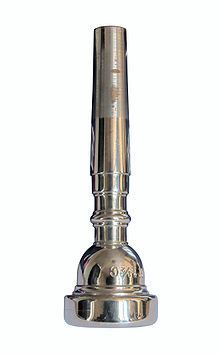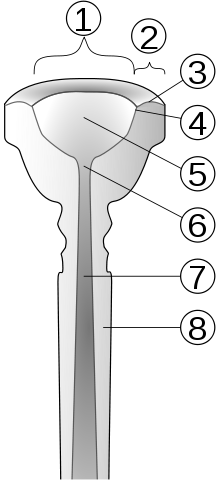- Mouthpiece (brass)
-
On brass instruments the mouthpiece is the part of the instrument which is placed upon the player's lips. The purpose of the mouthpiece is a resonator, which passes vibration from the lips to the column of air contained within the instrument, giving rise to the standing wave pattern of vibration in the air column. Mouthpieces consist of a simple circular opening which leads, via a semi-spherical or conical cavity, to the main body of the instrument.
Mouthpieces vary to instrument to suit the tone of the instrument. Lower instruments also have larger mouthpieces, to maximize resonance (see pitch of brass instruments). Also, mouthpieces are selected to suit the embouchure of the player, to produce certain timbre, or to optimize the instrument for certain playing styles. For example, trumpet and trombone mouthpieces are usually semi-spherical whereas horn mouthpieces are conic.
Contents
Mouthpiece design
The mouthpiece has a large effect on the sound of the instrument. The major effects are due to the shape of the cup, shape of the throat, and the inner rim diameter. In addition players often choose a mouthpiece which complements their favored playing styles; a mouthpiece with a narrow bore is generally preferred by brass players who concentrate on the upper range of their instrument, and a wider bore by those who emphasize the lower range of their instrument in their playing.
The effects of different aspects of mouthpiece design Mouthpiece element Effect on playing Typical size/nature
(Trumpet)Typical size/nature
(Tuba)Inner rim diameter Larger inner rim diameters are optimized for lower ranges, giving a richer tone. Smaller diameters assist high range playing. ~16.0mm ~32mm Rim width Wider rim widths reduce the pressure on the lips, allowing greater stamina. It does, however, reduce flexibility. ~5, 6, or 7mm ~6mm Rim contour Flatter rim contours tend to be found on rims with sharper rim edges (see below). Varied Varied Rim edge (or bite) Sharper rim edges reduce stamina but increase control. More smoothed rims are commonly found on deeper cups. Varied varied Cup depth Shallower cups greatly assist playing in high ranges but do so at the cost of fullness of tone. Deeper cups assist low range flexibility and rich tone. Around half the inner rim diameter. 3/4 to 2 times the inner rim diameter. Cup shape Semi-spherical cups have brighter, more projected tones, while conical cups have less tone definition (see throat contour, below). Semi-spherical Both Throat contour In semi-spherical cups, a sharper throat contour gives a more harsh, projected tone and a rounded contour gives a deeper, richer tone. Conical cups with a smooth throat have less definition. Relatively sharp Usually rounded Throat diameter Larger throat diameters give more volume but less control. Smaller diameters have much more control but significant volume limitations. ~3.6mm ~7.6mm Backbore More conical backbores give a richer tone, while more cylindrical ones give a brighter, more projected tone. Fairly cylindrical Varied Note: in this table: - "flexibility" refers to the 'agility' possibility; greater flexibility assists in playing music with fast passages and large intervals.
- "control" refers to the ease of control over harmonic and tone.
- "rich tone" refers to notes possessing few high harmonics, while "bright tone" refers to notes possessing many high harmonics.
Material
There are 5 types of material available for brass players, each with different costs, properties, and features. Note that some of the following assertions, especially those regarding the effect of plating on tone color, are considered by the majority of players and specialists to be very questionable.[citation needed]
Gold plating
For some players, there is an option available to gold-plate your brass mouthpieces. Some believe this creates a fuller, richer tone that can also be somewhat darker timbre.[dubious ][citation needed] For some people who are allergic to silver, this is the best (but not cheapest) way to keep playing on a brass instrument without discomfort. Gold does not tarnish by nature and subsequently requires little maintenance apart from washing regularly with soap and water.
Silver plating
Silver plating is standard on all brass mouthpieces because it is the most cost-effective, and is a good material in terms of tone quality. Silver plating is not as comfortable or as expensive as gold, but still has properties and qualities that are sometimes necessary for some styles of playing[dubious ]. Silver-plate gives a clearer, darker sound than gold[dubious ] and is good for styles of playing that need clarity and projection. In addition, silver-plate is less valuable than gold but requires more maintenance as a result of its tendency to tarnish easily. Slightly tarnished silver-plate can be polished back to its brightness with some forms of silver polish.
Plastic
A third option is a plastic mouthpiece made out of Lexan plastic. Some of the positive features of these mouthpieces are that they are very durable and will not chip nor dent as is the case with metal mouthpieces, they are very affordable compared to metal mouthpieces, and they are commonly used when playing in outdoor conditions as a result of their short "warm-up" time. They are widely referred to marching brass players because of these features listed above. The negative aspect of this type of mouthpiece is that it may not have the same tone quality and feel as metal mouthpieces do.[dubious ]
Other
Two more recent additions to the mouthpiece world are stainless steel and titanium. They are relatively rare, being produced by very few manufacturers. Stainless steel and titanium mouthpieces hold many advantages to the classic brass mouthpiece, including, anecdotally, a much more centered feel and sound,[dubious ][citation needed] as stainless steel and titanium do not absorb as many vibrations as brass;[citation needed] they require much less care; etc., but they are much more expensive (titanium mouthpieces run up to about $400 each).
Sizes
Each mouthpiece company has different labeling system. A larger number might mean a larger or smaller mouthpiece depending on the company. Likewise, the letters mean different things depending on the company.
See also
- leadpipe
- brass instrument
- embouchure
- gold plating
- silver
Categories:- Brass instrument parts and accessories
Wikimedia Foundation. 2010.


